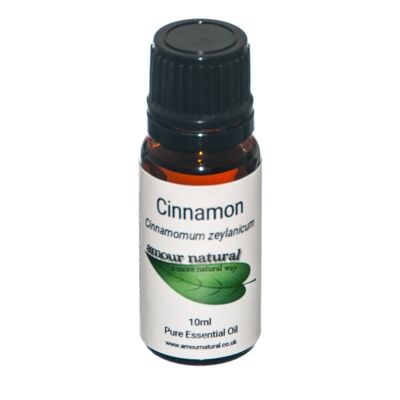


10ml Cinnamon Essential Oil Cinnamon Essential Oil is generally used cosmetically or topically. Cinnamon Essential Oil is claimed to calm dry skin, effectively alleviate aches, pains, and stiffness in the muscles and joints, address acne, rashes, and infections, enhance circulation, nourish the skin, slow the look of aging and revive the skin tone. - 10ml Cinnamon Essential Oil - Botanical Name: Cinnamomum zeylanicum - Common Method of Extraction: Steam Distilled - Part Typically Used: Leaf or Bark - Colour: Golden Yellow/Brown - Consistency: Slightly oily feeling - Perfumery Note: Middle - Strength of Initial Aroma: Strong - Aromatic Description: Much richer in aroma than ground cinnamon. (Ground cinnamon and cinnamon sticks is usually not cinnamon at all but is cassia - Cinnamon Oil Uses: Constipation, exhaustion, flatulence, lice, low blood pressure, rheumatism, scabies, stress. [Julia Lawless, The Illustrated Encyclopaedia of Essential Oils (Rockport, MA: 1995), 58-67.] - Bark Oil Major Constituents: (E)-Cinnamaldehyde Eugenol (E)-Cinnamyl acetate Linalool B-Caryophyllene p-Cymene Safety Information: Tisserand and Young indicate that both the bark and the leaf oil are low risk for mucous membrane irritation, may inhibit blood clotting and pose a drug interaction hazard. Cinnamon Bark Oil may cause embryotoxicity and is contraindicated in pregnancy and breasfeeding. There is a high risk of skin sensitization with the bark oil, and Tisserand and Young recommend a dermal maximum of 0.07% for the bark oil. For the leaf oil, Tisserand and Young recommend a dermal maximum of 0.6%. Reading Tisserand and Young's full profile for both the bark and leaf oils is recommended. [Robert Tisserand and Rodney Young, Essential Oil Safety (Second Edition. United Kingdom: Churchill Livingstone Elsevier, 2014), 248-250.]






























